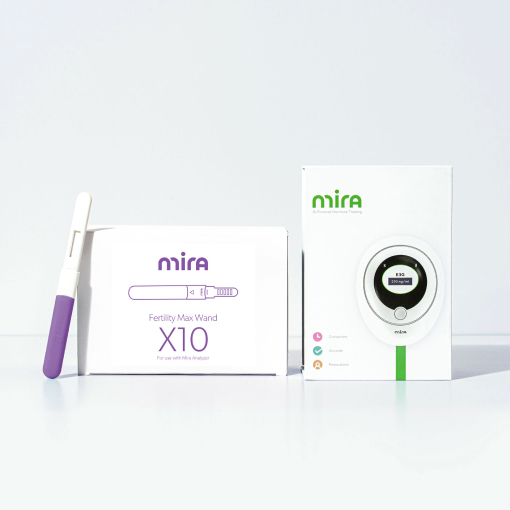Ovulation Symptoms: 5 Signs of Ovulation

Ovulation is an important milestone in your menstrual cycle and an important indicator of fertility. It’s the process by which an egg is released from an ovary and is ready to be fertilized. Keeping track of the timing of ovulation can help you plan a pregnancy or avoid one as well. In this article, we’ll be focusing on the process of ovulation, how it works, and when it occurs. We’ll also shed light on some of the most common ovulation symptoms, how you can keep track of when you ovulate, and how to use this information whether you’re planning a pregnancy or planning to avoid one.
Key Takeaways
Every menstrual cycle has two milestones: a period and ovulation. Understanding ovulation and the process behind it can be an important factor in understanding your fertility. Traditional methods of tracking involve paying attention to common ovulation symptoms. Signs like changes in your basal body temperature, changes in cervical mucus, and mood changes can all be used as predictors that ovulation is about to take place or has already occurred.
Regardless of when you ovulate, your sex hormones follow a predictable path before ovulation. Your hormone levels are one of the most accurate and fundamental ovulation symptoms that you can track. Even if you are not trying to conceive, hormone testing can help you understand other aspects of your reproductive health.
What is Ovulation?
Ovulation is a reoccuring event of your menstrual cycles where an egg is released from the ovaries. Your cycle can be broken up into two phases: the follicular phase and the luteal phase.
At the beginning of the follicular phase, the follicle stimulating hormone (FSH) rises. This hormone helps to develop an ovarian follicles, one of which will eventually house an egg. FSH also helps to stimulate the production of estrogen, which supports the further development of the follicle and egg, while also thickening the uterine lining.
Next, as the follicle develops luteinizing hormone (LH) surges and triggers the body to ovulate. The whole process of ovulation involves the egg being released from the follicle. Then the egg travels down the fallopian tube towards the uterus.
After its release, the egg has between 12-24 hours to be fertilized by a sperm. If it is not fertilized, it disintegrates and is shed alongside the uterine lining during the menstrual period. If the egg is fertilized, it may result in pregnancy.
You are considered at “peak” fertility in the days leading up to ovulation as LH surges and on the day of ovulation since these are the days you are most likely to get pregnant. This period of time is known as your fertile window are 5 days before ovulation ( the lifespan of sperm) and one day as ovulation happened(the lifespan of egg)
Common Ovulation Symptoms
There are a number of common signs and symptoms that may occur during ovulation. Not everyone experiences them and they can change from month to month.
The most common ovulation symptoms include:
Light cramps
One in five people experience light cramping or pain around the time of ovulation. Ovulation pain is commonly referred to as “mittelschmerz” from the German words for “middle” and “pain”. This pain can occur around ovulation and often feels like sharp pain or pressure in the lower abdomen.
Changes in cervical mucus
You may notice your discharge resembles the look and texture of raw egg whites around the time of ovulation. It’s common for your cervical mucus to change around the time of ovulation due to fluctuating hormone levels. It may increase in volume along with changes in texture and consistency.
Breast tenderness
Some people may experience changes in their breast tissue during ovulation. Breast tenderness or sore nipples are often reported as ovulation symptoms.
Libido changes
It’s common to experience an increase in libido around the time of ovulation. This is simply nature’s way of saying that it’s the right time to try to conceive.
Mood swings
Any time there are hormonal changes, you may be at risk of experiencing mood swings. Fluctuations in estrogen, luteinizing hormone, and progesterone can all lead to mood swings and you may experience a variety of emotional states like sadness, sensitivity, restlessness, or a surge in energy.
Tracking Ovulation
Whether you are trying to get pregnant or trying to avoid getting pregnant, it can be useful to track ovulation. As one of the key milestones of your menstrual cycle, tracking ovulation patterns can be especially beneficial for family planning or getting to know more about your reproductive health.
There are several different methods you can use to track ovulation. Each comes with their own set of pros and cons.
Calendar Method
One of the most basic ways to track ovulation is by following the Calendar Method. This method uses a mathematical formula to estimate your day of ovulation based on your cycle length and the first day of your last period. This method is also known as menstrual cycle charting and is a low cost and low tech solution to tracking ovulation.
Basal Body Temperature Method
Another method that you can try is the Basal Body Temperature (BBT) Method. With this method, you must take your temperature at the same time each day (usually in the morning). Over time, you will be able to spot the sudden rise in temperature around ovulation, and potentially predict when it will rise in the next cycle.

Ovulation Predictor Kits
Ovulation predictor kits are another option for tracking ovulation. These tests are similar to the pee-on-stick variety of pregnancy tests and are designed to detect the rise or “surge” in LH in your body. They do not measure the exact day of ovulation, but rather the rise in LH that occurs before ovulation.
Fertility monitors are digital devices that track data about your menstrual cycle. They have become increasingly popular to predict ovulation and identify an individual’s most fertile days. There are a variety of different types of fertility monitors ranging from thermometers and armbands to vaginal devices.
Accurate ovulation tracking with Mira
One of the most accurate ways to track and predict ovulation is by tracking your hormones directly. This can be done with an at-home hormone tracking device like Mira. With Mira, you can track key hormone levels like estrogen (E3G), LH, progesterone (PdG), and FSH in a simple and non-invasive way. You can get precise daily hormone level readings, similar to those from a lab, and monitor your hormonal map over time through dynamic charts on your smartphone – clearly pinpointing your ovulation patterns. You can also make use of ovulation calculators that aim to predict ovulation based on the dates of your menstrual cycle that you input. However, online ovulation calculators are sometimes lacking and the ovulation symptoms can vary strongly from person to person.

Ovulation and Fertility: What You Need to Know
Ovulation and fertility are inextricably linked. Your fertility depends on your menstrual cycle and the phases that occur within it. Knowing when ovulation happens is critical to getting pregnant since your window of opportunity is fairly small each month. There are many factors that affect fertility, but you are most likely to conceive during the six days of your fertile window. For most people, this begins four to five days before ovulation and ends the day after ovulation. This is because the lifespan of sperm is up to five days and the lifespan of an egg is 12-24 hours after it is released.
Within this fertile window, your chances of becoming pregnant increase as you approach your ovulation day, with your highest chances on the days before and the day of ovulation. On the other days outside of your fertile window, your chances of conceiving are very low. That’s why it is so important to be aware of when your fertile window is, so that you can plan to have sex during this time or take precautions if you are TTA.
To maximize your chances of getting pregnant it’s important to have sex with your partner around the time of ovulation, i.e. your fertile window. Based on research, your chances of conceiving during this time are as follows:
- Day 5 Before Ovulation: 1.4-7% chance of conception
- Day 4 Before Ovulation: 8-17%
- Day 3 Before Ovulation: 8-23%
- Day 2 Before Ovulation: 13-29%
- Day 1 Before Ovulation: 21-24%
- Day of Ovulation: 8-33%
- Day 1 After Ovulation: 0.8-11%
Experts recommend having sex with your partner daily or at least every other day during this period of time in order to maximize your chances of becoming pregnant. This can require a bit of planning and taking time to understand how your hormones work throughout the ovulation process.
One of the best methods for planning for your peak fertility is by testing and tracking your hormone levels. Using an at-home smart hormone tracker like Mira, you can see your actual hormone concentrations with over 99% accuracy. The data is then automatically synced with the Mira app, which optimizes the ovulation prediction based on your personal health. If you’re actively planning a pregnancy, being able to pinpoint your fertile window is crucial to getting pregnant and getting pregnant as fast as possible.
Ovulation Complications and Solutions
Some conditions may cause potential issues with ovulation. Many people have irregular periods and may struggle to predict ovulation, or may not ovulate at all. Irregular cycles can make traditional methods, like the basal body temperature method, checking cervical mucus, or the calendar method inaccurate. Ovulation predictor kits (OPK) can be faulty for those with irregular periods and tracking your period alone will not tell you if you’ve ovulated or not. Using a hormone testing device like Mira is a more effective way to determine your fertile window. Your daily levels of actual hormone concentrations are measured (with 99% accuracy) to detect when ovulation does (or does not) occur.
If you have a hormonal imbalance, like PCOS, ovulation may not always take place and estrogen and LH levels may not follow predictable patterns. The hormonal imbalance associated with PCOS can create problems in the ovaries which means they may not release an egg during ovulation like they should. This makes ovulation testing that much more challenging.
Since your hormones may not follow a predictable path, predicting ovulation can be a challenge for those with PCOS. To better understand your cycle, you can track your actual hormone concentrations with the help of a digital fertility analyzer. The Mira device tracks hormone levels and gives you actual LH levels throughout your cycle. You can see your hormone curve and still see your ovulation even if your baseline LH is high. This can help you better understand your cycles and the hormone data that Mira provides can be extremely useful for those with PCOS.
Final thoughts
Regardless of your goals, ovulation is a key indicator of your fertility and menstrual health. Keeping track of when ovulation takes place can help you reach your fertility goals. There are many methods to keep track of the signs and symptoms of ovulation that vary from low to high tech solutions. Of course, cycles vary from person to person and even month to month. If you struggle with a hormonal condition like PCOS, you may find it hard to rely on traditional tracking methods.
A better understanding of ovulation will not only give you more insight into your menstrual cycle, but can help you manage your fertility better. By detecting your most fertile time, you can make informed decisions about your fertility.
Ovulation FAQs
How long does ovulation last?
Ovulation itself is a moment. The time around ovulation lasts approximately 24-36 hours. This includes the entire process surrounding ovulation, including the LH surge. However, this time frame can vary among women, and can even vary from cycle to cycle. Your fertile window also includes the days leading up to ovulation as well as the event itself, and statistically speaking, is when you have the most chance of getting pregnant.
Can you feel when you are ovulating?
Yes. Some people who menstruate experience cramps or mild to moderate pelvic pain during ovulation. The pain or cramping may occur on one or both sides and is commonly referred to as mittelschmerz (from the German words for “middle” and “pain”). You may also notice your body producing more discharge. It’s common for cervical mucus or discharge to appear yellow, white, or cloudy white in color and appear stickier than normal. This type of discharge is a sign that a developing egg in your ovaries is ripening and preparing for release through ovulation.
What are the signs of not ovulating?
There are different reasons why you may not be ovulating. Anovulation (no ovulation) means no egg was released so the signs of ovulation may also be absent. The signs of not ovulating include missed periods, lack of cervical mucus, excessive bleeding during periods, irregular basal body temperature readings, irregular LH test results, and a period that stays light and never gets heavier.
After ovulation, how do I know if I’m pregnant?
Some women may begin to feel signs of pregnancy as early as five days before their expected period, but that may also be from a chemical pregnancy rather than a viable one. On average you should wait at least two weeks after ovulation to take a pregnancy test or until the first day of your missed period.
Recommended for you
Navigate your fertility with peace of mind
Mira’s Editorial Process
All content produced by Mira meets stringent editorial standards, ensuring excellence and accuracy in language and medical precision. Every piece undergoes thorough fact-checking and review by qualified professionals. Check out our full editorial process to learn more.














